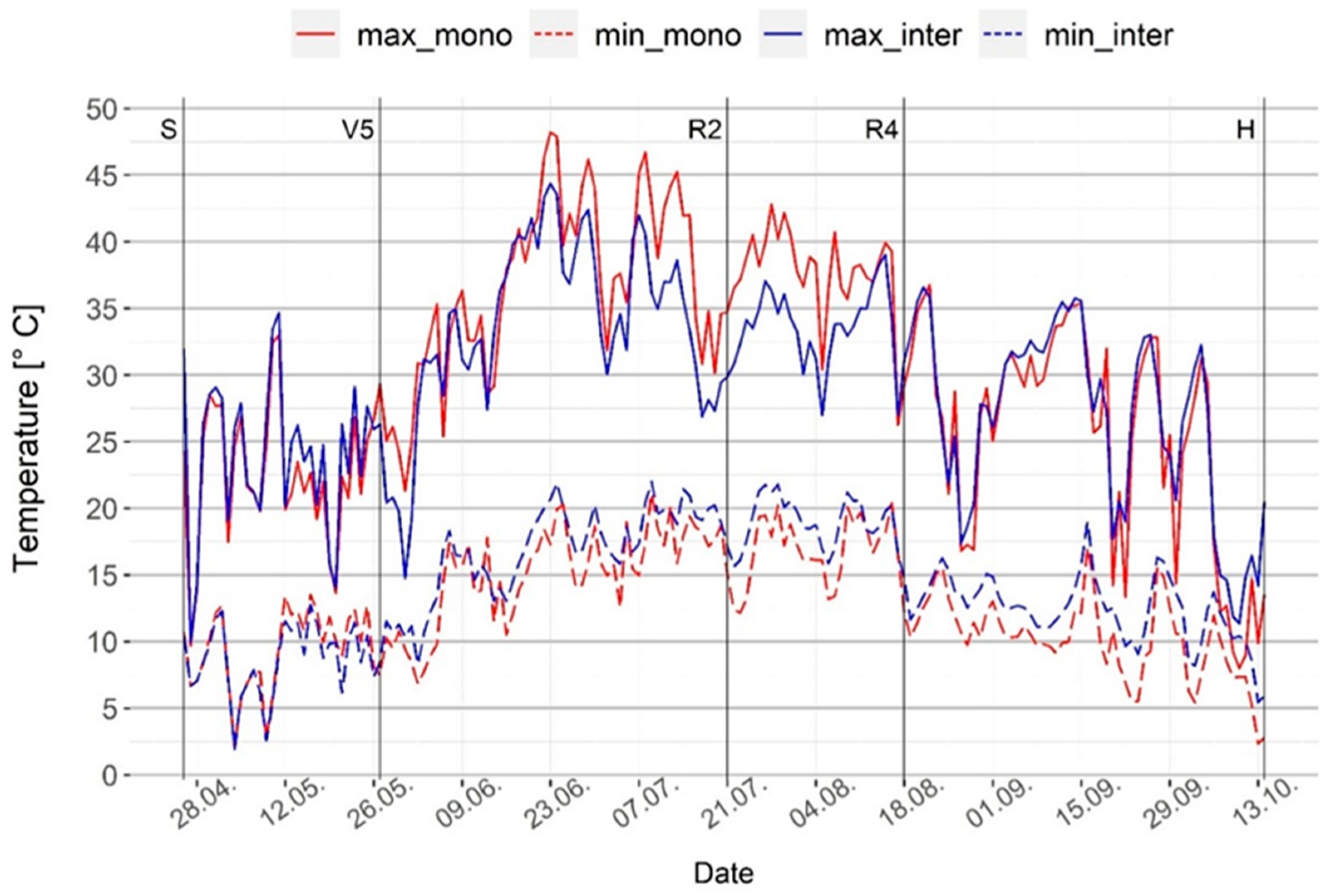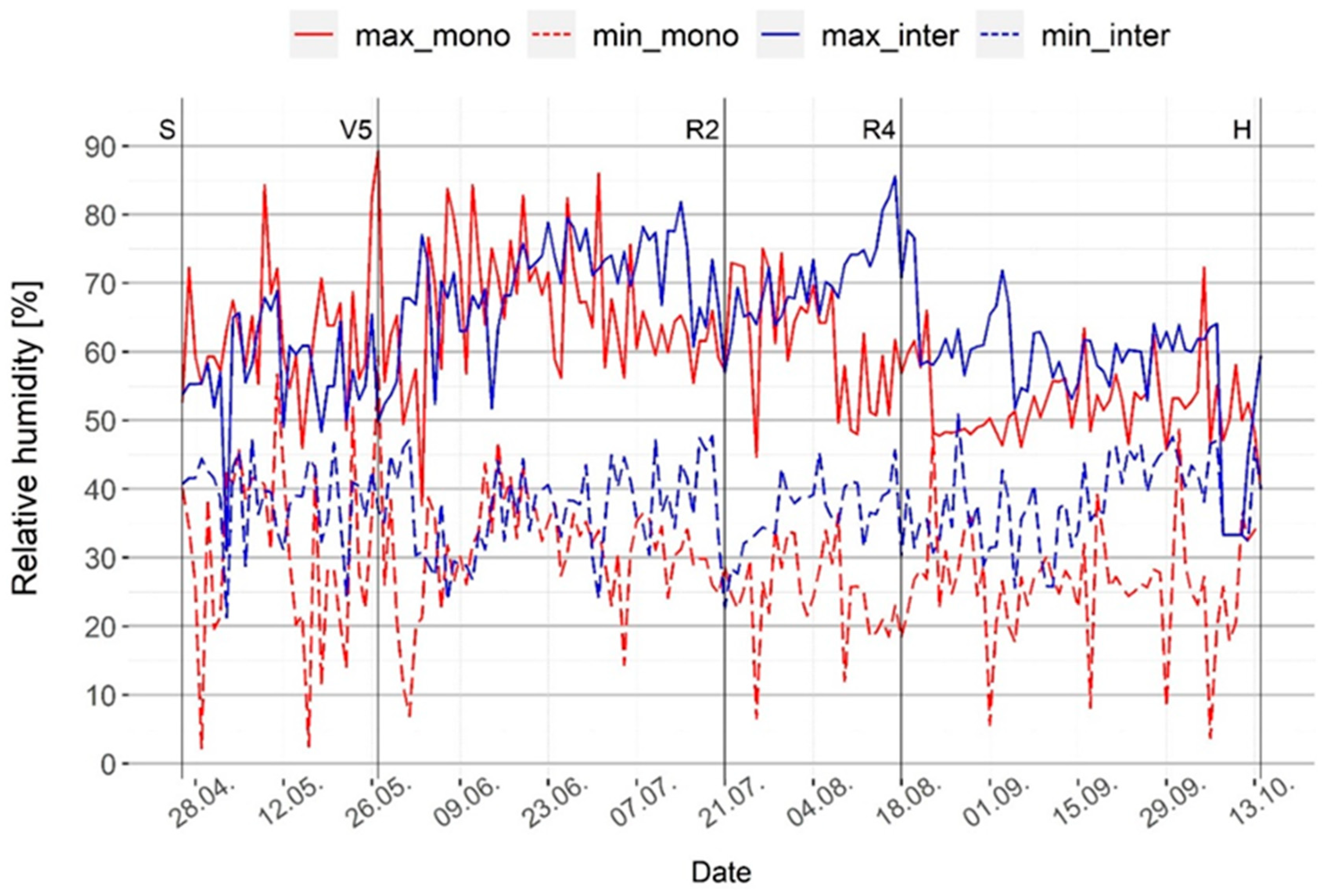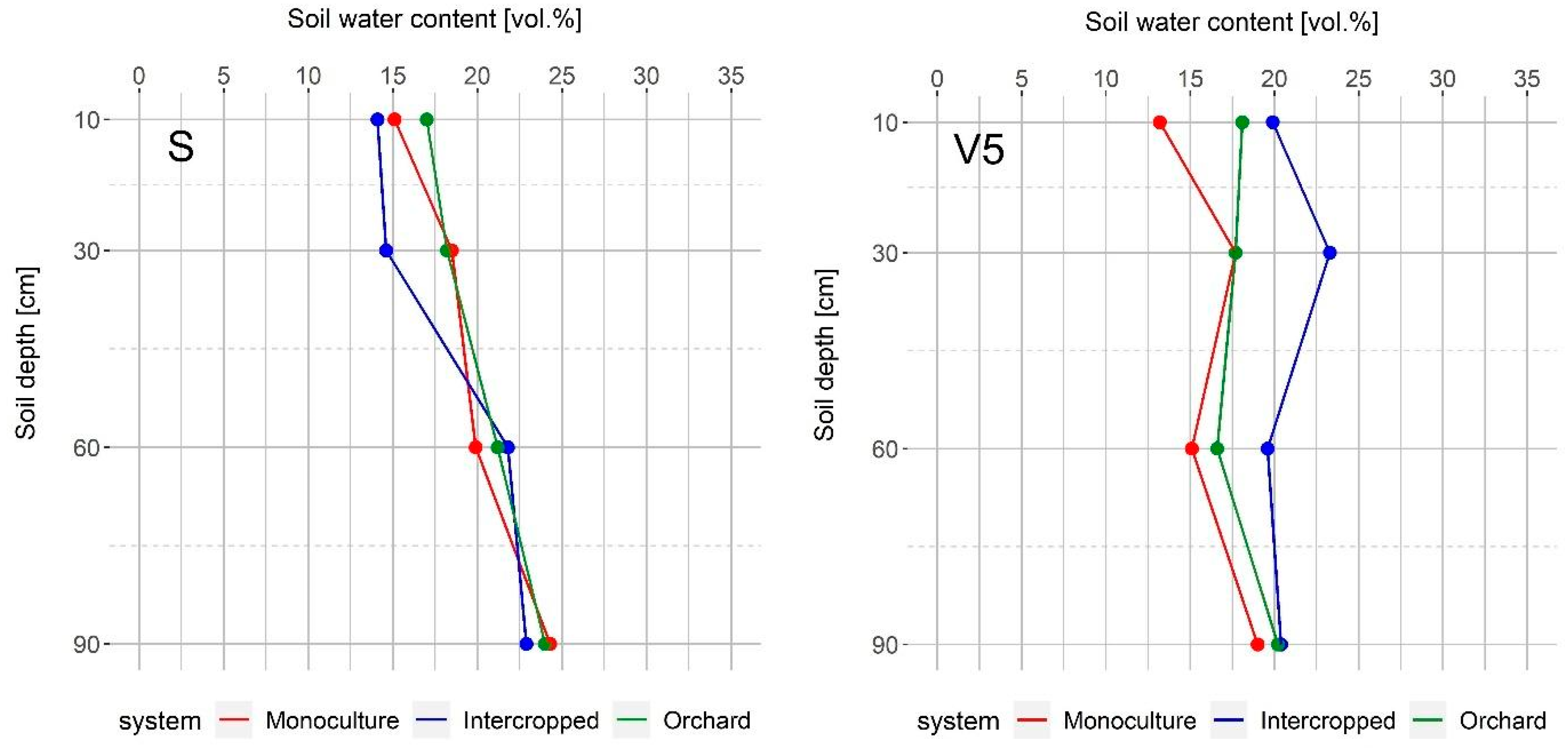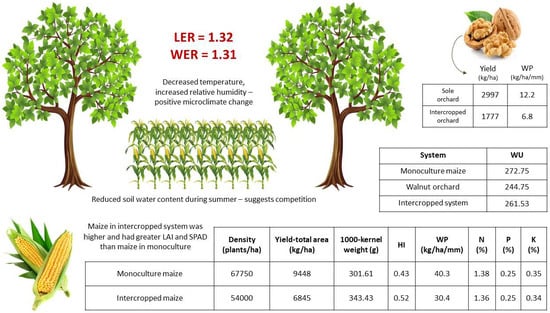Ecological and Agronomic Benefits of Intercropping Maize in a Walnut Orchard—A Case Study
Abstract
:1. Introduction
2. Materials and Methods
2.1. Field Experiments and Systems Design
2.2. Meteorological Data
- K > 1.5: excessive humidity for most plants;
- 1 < K < 1.5: humidity sufficient for most plants;
- 0.5 < K < 1.0: insufficient humidity for most plants;
- K < 0.5: drought.
2.3. Soil Water Content
2.4. Sampling, Measurements, and Analysis
2.5. Yields Determination
2.6. Land Equivalent Ratio (LER)
2.7. Water Use (WU), Water Productivity (WP), and Water Equivalent Ratio (WER)
2.8. Nutrient Indices
2.9. Statistical Analysis
3. Results and Discussion
3.1. Microclimate Conditions
3.2. Soil Water Content
3.3. Soil Chemical Properties
3.4. Maize Growth and Leaf Greenness during Vegetation
3.5. Yields, Yield Components, and LER
3.6. Water Use, Water Productivity, and Water Equivalent Ratio
3.7. Nutrient Indices
4. Conclusions
Author Contributions
Funding
Data Availability Statement
Acknowledgments
Conflicts of Interest
References
- Raftery, A.E.; Zimmer, A.; Frierson, D.M.W.; Startz, R.; Liu, P. Less than 2 °C warming by 2100 unlikely. Nat. Clim. Chang. 2017, 7, 637–641. [Google Scholar] [CrossRef] [PubMed]
- Kamali, B.; Abbaspour, K.C.; Wehrli, B.; Yang, H. Drought vulnerability assessment of maize in Sub-Saharan Africa: Insights from physical and social perspectives. Glob. Planet. Chang. 2018, 162, 266–274. [Google Scholar] [CrossRef] [Green Version]
- IPCC. Summary for Policymakers. Managing the Risks of Extreme Events and Disasters to Advance Climate Change Adaptation; Field, C.B., Barros, V., Stocker, T.F., Qin, D., Dokken, D.J., Ebi, K.L., Mastrandrea, M.D., Mach, K.J., Plattner, G.K., Allen, S.K., et al., Eds.; A Special Report of Working Groups I and II of the Intergovernmental Panel on Climate Change; Cambridge University Press: Cambridge, UK; New York, NY, USA, 2012; pp. 1–19. [Google Scholar]
- Gosme, M.; Inurreta-Aguirre, H.D.; Dupraz, C. Microclimatic effect of agroforestry on diurnal temperature cycle. In Proceedings of the 3rd European Agroforestry Conference, European Agroforestry Federation, Montpellier, France, 23–25 May 2016; pp. 183–186. [Google Scholar]
- van Noordwijk, M. Agroforestry-based ecosystem services. Land 2021, 10, 770. [Google Scholar] [CrossRef]
- Zhu, X.; Liu, W.; Chen, J.; Bruijnzeel, L.A.; Mao, Z.; Yang, X.; Cardinael, R.; Meng, F.-R.; Sidle, R.C.; Seitz, S.; et al. Reductions in water, soil and nutrient losses and pesticide pollution in agroforestry practices: A review of evidence and processes. Plant Soil 2019, 453, 45–86. [Google Scholar] [CrossRef]
- Isaac, M.E.; Borden, K.A. Nutrient acquisition strategies in agroforestry systems. Plant Soil 2019, 444, 1–19. [Google Scholar] [CrossRef]
- Reynolds, P.E.; Simpson, J.A.; Thevathasan, N.V.; Gordon, A.M. Effects of tree competition on corn and soybean photosynthesis, growth, and yield in a temperate tree-based agroforestry intercropping system in southern Ontario, Canada. Ecol. Eng. 2007, 29, 362–371. [Google Scholar] [CrossRef]
- Simpson, J.A. Effects of Shade on Maize and Soybean Productivity in a Tree Based Intercrop System. Master’s Thesis, The University of Guelph, Guelph, ON, Canada, 1999. [Google Scholar]
- Gillespie, A.R.; Jose, S.; Mengel, D.B.; Hoover, W.L.; Pope, P.E.; Seifert, J.R. Defining competition vectors in a temperate alley cropping system in the midwestern USA: 1. Production physiology. Agrofor. Syst. 2000, 48, 25–40. [Google Scholar] [CrossRef]
- Jose, S.; Gillespie, A.R.; Seifert, J.R.; Biehle, D.J. Defining competition vectors in a temperate alley cropping system in the midwestern USA: 2. Competition for water. Agrofor. Syst. 2000, 48, 41–59. [Google Scholar] [CrossRef]
- Harawa, R.; Lehmann, J.; Akinnifesi, F.; Fernandes, E.; Kanyama-Phiri, G. Nitrogen dynamics in maize-based agroforestry systems as affected by landscape position in Southern Malawi. Nutr. Cycl. Agroecosyst. 2006, 75, 271–284. [Google Scholar] [CrossRef]
- Amadi, D.C.; Idiege, D.A.; Sobola, O.O. Agroforestry technique and its influence on maize crop yield in Gombi local government, Adamawa state, Nigeria. IOSR J. Agric. Vet. Sci. 2013, 4, 52–55. [Google Scholar] [CrossRef]
- Taha, N.A.; Al-wadaan, M.A. Utility and importance of walnut, Juglans regia Linn: A review. Afr. J. Microbiol. Res. 2011, 5, 5796–5805. [Google Scholar] [CrossRef]
- Tengnas, B. Agroforestry Extension Manual for Kenya. Nairobi; International Centre for Research in Agroforestry: Nairobi, Kenya, 1994. [Google Scholar]
- Kocacë Aliskan, I.; Terzi, I. Allelopathic effects of walnut leaf extracts and juglone on seed germination and seedling growth. J. Hortic. Sci. Biotechnol. 2001, 76, 436–440. [Google Scholar] [CrossRef]
- Selyaninov, G.T. About climate agricultural estimation. Proc. Agric. Meteorol. 1928, 20, 165–177. [Google Scholar]
- Žalac, H.; Zebec, V.; Ivezić, V.; Herman, G. Land and water productivity in intercropped systems of walnut—buckwheat and walnut–barley: A case study. Sustainability 2022, 14, 6096. [Google Scholar] [CrossRef]
- McKee, G.W. A coefficient for computing leaf area in hybrid corn. Agron. J. 1964, 56, 240–241. [Google Scholar] [CrossRef]
- Yi, L.; Shenjiao, Y.; Shiqing, L.; Xinping, C.; Fang, C. Growth and development of maize (Zea mays L.) in response to different field water management practices: Resource capture and use efficiency. Agric. For. Meteorol. 2010, 150, 606–613. [Google Scholar] [CrossRef]
- Mead, R.; Willey, R.W. The concept of a ‘land equivalent ratio’ and advantages in yields from intercropping. Exp. Agric. 1980, 16, 217–228. [Google Scholar] [CrossRef] [Green Version]
- Hillel, D. Introduction to Environmental Soil Physics, 1st ed.; Academic Press: Cambridge, MA, USA, 2003. [Google Scholar]
- Machado, S.; Petrie, S.; Rhinhart, K.; Ramig, R.E. Tillage effects on water use and grain yield of winter wheat and green pea in rotation. Agron. J. 2008, 100, 154–162. [Google Scholar] [CrossRef] [Green Version]
- Sainju, U.M.; Lenssen, A.W.; Allen, B.L.; Jabro, J.D.; Stevens, W.B. Crop water and nitrogen productivity in response to long-term diversified crop rotations and management systems. Agric. Water Manag. 2021, 257, 107149. [Google Scholar] [CrossRef]
- Mao, L.; Zhang, L.; Li, W.; van der Werf, W.; Sun, J.; Spiertz, H.; Li, L. Yield advantage and water saving in maize/pea intercrop. Field Crop. Res. 2012, 138, 11–20. [Google Scholar] [CrossRef]
- Bridgham, S.D.; Pastor, J.; McClaugherty, C.A.; Richardson, C.J. Nutrient-use efficiency: A litterfall index, a model, and a test along a nutrient-availability gradient in North Carolina peatlands. Am. Nat. 1995, 145, 1–21. [Google Scholar] [CrossRef]
- Schmidt, M.; Corre, M.D.; Kim, B.; Morley, J.; Göbel, L.; Sharma AS, I.; Setriuc, S.; Veldkamp, E. Nutrient saturation of crop monocultures and agroforestry indicated by nutrient response efficiency. Nutr. Cycl. Agroecosyst. 2020, 119, 69–82. [Google Scholar] [CrossRef]
- Allen, B.L.; Lenssen, A.W.; Sainju, U.M.; Jabro, J.D.; Stevens, W.B. Nitrogen use in barley hay influenced by crop diversification, tillage, and management. In Proceedings of the Great Plains Soil Fertility Conference, Denver, CO, USA, 1–2 March 2016; International Plant Nutrition Institute: Brookings, SD, USA; pp. 172–179. [Google Scholar]
- R Core Team. R: A Language and Environment for Statistical Computing; R Foundation for Statistical Computing: Vienna, Austria, 2022; Available online: https://www.R-project.org/ (accessed on 13 June 2022).
- Trnka, M.; Olesen, J.E.; Kersebaum, K.C.; Skjelvåg, A.O.; Eitzinger, J.; Seguin, B.; Peltonen-Sainio, P.; Rötter, R.; Iglesias, A.; Orlandini, S.; et al. Agroclimatic conditions in Europe under climate change. Glob. Chang. Biol. 2011, 17, 2298–2318. [Google Scholar] [CrossRef] [Green Version]
- Giorgi, F.; Lionello, P. Climate change projections for the Mediterranean region. Glob. Planet. Chang. 2008, 63, 90–104. [Google Scholar] [CrossRef]
- Državni Hidrometeorološki Zavod, Ocjena Mjeseca, Sezone, Godine. 2022. Available online: https://meteo.hr/klima.php?section=klima_pracenje¶m=ocjena&el=msg_ocjena&MjesecSezona=4&Godina=2021. (accessed on 1 May 2022).
- Temani, F.; Bouaziz, A.; Daoui, K.; Wery, J.; Barkaoui, K. Olive agroforestry can improve land productivity even under low water availability in the south Mediterranean. Agric. Ecosyst. Amp Environ. 2021, 307, 107234. [Google Scholar] [CrossRef]
- Panozzo, A.; Huang, H.-Y.; Bernazeau, B.; Meunier, F.; Turc, O.; Duponnois, R.; Prin, Y.; Vamerali, T.; Desclaux, D. Impact of olive trees on the microclimatic and edaphic environment of the understorey durum wheat in an alley orchard of the Mediterranean area. Agronomy 2022, 12, 527. [Google Scholar] [CrossRef]
- Karki, U.; Goodman, M.S. Microclimatic differences between mature loblolly-pine silvopasture and open-pasture. Agrofor. Syst. 2014, 89, 319–325. [Google Scholar] [CrossRef]
- Kanzler, M.; Böhm, C.; Mirck, J.; Schmitt, D.; Veste, M. Microclimate effects on evaporation and winter wheat (Triticum aestivum L.) yield within a temperate agroforestry system. Agrofor. Syst. 2019, 93, 1821–1841. [Google Scholar] [CrossRef]
- Liu, Y.; Zhang, X.; Zhao, S.; Ma, H.; Qi, G.; Guo, S. The depth of water taken up by walnut trees during different phenological stages in an irrigated arid hilly area in the Taihang mountains. Forests 2019, 10, 121. [Google Scholar] [CrossRef] [Green Version]
- Germon, A.; Cardinael, R.; Prieto, I.; Mao, Z.; Kim, J.; Stokes, A.; Dupraz, C.; Laclau, J.-P.; Jourdan, C. Unexpected phenology and lifespan of shallow and deep fine roots of walnut trees grown in a silvoarable Mediterranean agroforestry system. Plant Soil 2015, 401, 409–426. [Google Scholar] [CrossRef]
- Mohamed, A.; Monnier, Y.; Mao, Z.; Jourdan, C.; Sabatier, S.; Dupraz, C.; Dufour, L.; Millan, M.; Stokes, A. Asynchrony in shoot and root phenological relationships in hybrid walnut. New For. 2019, 51, 41–60. [Google Scholar] [CrossRef]
- Cardinael, R.; Chevallier, T.; Cambou, A.; Béral, C.; Barthès, B.G.; Dupraz, C.; Durand, C.; Kouakoua, E.; Chenu, C. Increased soil organic carbon stocks under agroforestry: A survey of six different sites in France. Agric. Ecosyst. Environ. 2017, 236, 243–255. [Google Scholar] [CrossRef] [Green Version]
- Pandey, D.N. Carbon sequestration in agroforestry systems. Clim. Policy 2002, 2, 367–377. [Google Scholar] [CrossRef]
- Peichl, M.; Thevathasan, N.V.; Gordon, A.M.; Huss, J.; Abohassan, R.A. Carbon sequestration potentials in temperate tree-based intercropping systems, southern Ontario, Canada. Agrofor. Syst. 2006, 66, 243–257. [Google Scholar] [CrossRef]
- Weerasrekara, C.; Udawatta, R.P.; Jose, S.; Kremer, R.J.; WeerasRekara, C. Soil quality differences in a row-crop watershed with agroforestry and grass buffers. Agrofo. Syst. 2016, 90, 829–838. [Google Scholar] [CrossRef]
- Muchane, M.N.; Sileshi, G.W.; Gripenberg, S.; Jonsson, M.; Pumariño, L.; Barrios, E. Agroforestry boosts soil health in the humid and sub-humid tropics: A meta-analysis. Agric. Ecosyst. Environ. 2020, 295, 106899. [Google Scholar] [CrossRef]
- Oelbermann, M.; Voroney, R.P.; Gordon, A. Carbon sequestration in tropical and temperate agroforestry systems: A review with examples from Costa Rica and southern Canada. Agric. Ecosyst. Environ. 2004, 104, 359–377. [Google Scholar] [CrossRef]
- Chander, K.; Goyal, S.; Nandal, D.P.; Kapoor, K.K. Soil organic matter, microbial biomass and enzyme activities in a tropical agroforestry system. Biol. Fertil. Soils 1998, 27, 168–172. [Google Scholar] [CrossRef]
- Pinho, R.C.; Miller, R.P.; Alfaia, S.S. Agroforestry and the improvement of soil fertility: A view from Amazonia. Appl. Environ. Soil Sci. 2012, 2012, 616383. [Google Scholar] [CrossRef]
- Sainepo, B.M.; Gachene, C.K.; Karuma, A. Assessment of soil organic carbon fractions and carbon management index under different land use types in Olesharo Catchment, Narok County, Kenya. Carbon Balance Manag. 2018, 13, 4. [Google Scholar] [CrossRef] [Green Version]
- Irving, L. Carbon Assimilation, Biomass Partitioning and Productivity in Grasses. Agriculture 2015, 5, 1116–1134. [Google Scholar] [CrossRef]
- Lee, D.W.; Baskaran, K.; Mansor, M.; Mohamad, H.; Yap, S.K. Irradiance and spectral quality affect Asian tropical rain forest tree seedling development. Ecology 1995, 77, 568–580. [Google Scholar] [CrossRef]
- Weselek, A.; Bauerle, A.; Hartung, J.; Zikeli, S.; Lewandowski, I.; Högy, P. Agrivoltaic system impacts on microclimate and yield of different crops within an organic crop rotation in a temperate climate. Agron. Sustain. Dev. 2021, 41, 59. [Google Scholar] [CrossRef]
- Monteith, J.L. Solar radiation and productivity in tropical ecosystems. J. Appl. Ecol. 1972, 9, 747. [Google Scholar] [CrossRef] [Green Version]
- Lawlor, D.W. Photosynthesis, productivity and environment. J. Exp. Bot. 1995, 46, 1449–1461. [Google Scholar] [CrossRef]
- Zhang, D.; Du, G.; Sun, Z.; Bai, W.; Wang, Q.; Feng, L.; Zheng, J.; Zhang, Z.; Liu, Y.; Yang, S.; et al. Agroforestry enables high efficiency of light capture, photosynthesis and dry matter production in a semi-arid climate. Eur. J. Agron. 2018, 94, 1–11. [Google Scholar] [CrossRef]
- Ivezić, V.; Žalac, H.; Jović, J.; Stošić, M.; Iljkić, D.; Zebec, V. Shading effect on crop yields in intercropped systems of walnut and agricultural crops. In Book of Abstracts, Proceedings of the 5th European Agroforestry Conference: Agroforestry for the Transition towards Sustainability and Bioeconomy, Nuoro, Italy, 17–19 May 2021; European Agroforestry Federation: Nuoro, Italy; pp. 111–112.
- Talbot, G.; Roux, S.; Graves, A.; Dupraz, C.; Marrou, H.; Wery, J. Relative yield decomposition: A method for understanding the behaviour of complex crop models. Environ. Model. Amp Softw. 2014, 51, 136–148. [Google Scholar] [CrossRef]
- Rao, M.R.; Nair, P.K.R.; Ong, C.K. Biophysical interactions in tropical agroforestry systems. Dir. Trop. Agrofor. Res. 1998, 38, 3–50. [Google Scholar] [CrossRef] [Green Version]
- Dufour, L.; Metay, A.; Talbot, G.; Dupraz, C. Assessing light competition for cereal production in temperate agroforestry systems using experimentation and crop modelling. J. Agron. Crop. Sci. 2012, 199, 217–227. [Google Scholar] [CrossRef]
- Artru, S.; Garré, S.; Dupraz, C.; Hiel, M.-P.; Blitz-Frayret, C.; Lassois, L. Impact of spatio-temporal shade dynamics on wheat growth and yield, perspectives for temperate agroforestry. Eur. J. Agron. 2017, 82, 60–70. [Google Scholar] [CrossRef]
- Islam, A.K.M.M.; Widhalm, J.R. Agricultural uses of juglone: Opportunities and challenges. Agronomy 2020, 10, 1500. [Google Scholar] [CrossRef]
- Hütsch, B.W.; Schubert, S. Harvest index of maize (Zea mays L.): Are there possibilities for improvement? Adv. Agron. 2017, 146, 37–82. [Google Scholar] [CrossRef]
- Ciampitti, I.A.; Vyn, T.J. A comprehensive study of plant density consequences on nitrogen uptake dynamics of maize plants from vegetative to reproductive stages. Field Crop. Res. 2011, 121, 2–18. [Google Scholar] [CrossRef]
- Shao, R.-X.; Yu, K.-K.; Li, H.-W.; Jia, S.-J.; Yang, Q.-H.; Zhao, X.; Zhao, Y.-L.; Liu, T.-X. The effect of elevating temperature on the growth and development of reproductive organs and yield of summer maize. J. Integr. Agric. 2021, 20, 1783–1795. [Google Scholar] [CrossRef]
- Li, H.; Jiang, D.; Wollenweber, B.; Dai, T.; Cao, W. Effects of shading on morphology, physiology and grain yield of winter wheat. Eur. J. Agron. 2021, 33, 267–275. [Google Scholar] [CrossRef]
- Wenzel, W.; Ayisi, K.K.; Donaldson, G. Importance of harvest index in drought resistance of sorghum. J. Appl. Bot. 2000, 74, 203–205. [Google Scholar]
- Bunce, J.A. Abscisic acid mimics effects of dehydration on area expansion and photosynthetic partitioning in young soybean leaves. Plant Cell Environ. 1990, 13, 295–298. [Google Scholar] [CrossRef]
- Jama, B.A.; Nair, P.K.R.; Rao, M.R. Productivity of hedgerow shrubs and maize under alleycropping and block planting systems in semiarid Kenya. Agrofor. Syst. 1995, 31, 257–274. [Google Scholar] [CrossRef]
- Karimuna, L.; Halim; Ansi, A.; Marfi, W.E.; Wijayanto, T.; Hasanuddin, L. Growth and yields of two varieties of maize (Zea mays L.) intercropped with peanut (Arachys hypogaea L.) applied by bokashi plus fertilizer between the rows of teak trees based agroforestry system. IOP Conf. Ser. Earth Environ. Sci. 2022, 951, 012041. [Google Scholar] [CrossRef]
- Selim, M.A.F.; Shams, A.S. Maximizing efficiency of land and water utilization and profitability of interplanting maize with mandarin trees using irrigation with fish waste water under sandy soil and drip irrigation conditions. Middle East J. Agric. Res. 2019, 8, 1240–1252. [Google Scholar] [CrossRef]
- Bellow, J.G.; Nair, P.K.R.; Martin, T.A. Tree-Crop interactions in fruit tree-based agroforestry systems in the western Highlands of Guatemala: Component yields and system performance. Adv. Agrofor. 2008, 4, 111–131. [Google Scholar] [CrossRef]
- Žalac, H.; Burgess, P.; Graves, A.; Giannitsopoulos, M.; Paponja, I.; Popović, B.; Ivezić, V. Modelling the yield and profitability of intercropped walnut systems in Croatia. Agrofor. Syst. 2021, 14, 6096. [Google Scholar] [CrossRef]
- Ivezić, V.; Stošić, M.; Zebec, V.; Popović, B.; Puškarić, J.; Ilić, J.; Jović, J. Walnut and crop yields in walnut orchards intercropped with wheat. In Book of Abstracts of the 4th World Congress on Agroforestry, Montpellier, France, 20–25 May 2019; Springer: Berlin/Heidelberg, Germany, 2021; p. 318. [Google Scholar]
- Liu, Z.; Jia, G.; Yu, X. Water uptake and WUE of Apple tree-Corn Agroforestry in the Loess hilly region of China. Agric. Water Manag. 2020, 234, 106138. [Google Scholar] [CrossRef]
- Pardon, P.; Mertens, J.; Reubens, B.; Reheul, D.; Coussement, T.; Elsen, A.; Nelissen, V.; Verheyen, K. Juglans regia (walnut) in temperate arable agroforestry systems: Effects on soil characteristics, arthropod diversity and crop yield. Renew. Agric. Food Syst. 2019, 35, 533–549. [Google Scholar] [CrossRef]
- Broadhead, J.; Ong, C.; Black, C. Tree phenology and water availability in semi-arid agroforestry systems. For. Ecol. Manag. 2003, 180, 61–73. [Google Scholar] [CrossRef]
- Jackson, N.; Wallace, J. Soil evaporation measurements in an agroforestry system in Kenya. Agric. For. Meteorol. 1999, 94, 203–215. [Google Scholar] [CrossRef]
- Lin, B.B. The role of agroforestry in reducing water loss through soil evaporation and crop transpiration in coffee agroecosystems. Agric. For. Meteorol. 2010, 150, 510–518. [Google Scholar] [CrossRef]
- Siriri, D.; Wilson, J.; Coe, R.; Tenywa, M.M.; Bekunda, M.A.; Ong, C.K.; Black, C.R. Trees improve water storage and reduce soil evaporation in agroforestry systems on bench terraces in SW Uganda. Agrofor. Syst. 2012, 87, 45–58. [Google Scholar] [CrossRef] [Green Version]
- Bai, W.; Sun, Z.; Zheng, J.; Du, G.; Feng, L.; Cai, Q.; Yang, N.; Feng, C.; Zhang, Z.; Evers, J.B.; et al. Mixing trees and crops increases land and water use efficiencies in a semi-arid area. Agric. Water Manag. 2016, 178, 281–290. [Google Scholar] [CrossRef]
- Haggar, J.; Tanner, E.; Beer, J.; Kass, D. Nitrogen dynamics of tropical agroforestry and annual cropping systems. Soil Biol. Biochem. 1993, 25, 1363–1378. [Google Scholar] [CrossRef]
- Isaac, M.E.; Timmer, V.R.; Quashie-Sam, S.J. Shade tree effects in an 8-year-old cocoa agroforestry system: Biomass and nutrient diagnosis of Theobroma cacao by vector analysis. Nutr. Cycl. Agroecosyst. 2007, 78, 155–165. [Google Scholar] [CrossRef]
- Žalac, H.; Zebec, V.; Stošić, M.; Popović, B.; Bubalo, A.; Jović, J.; Herman, G.; Paponja, I.; Ivezić, V. Barley yield, yield components and nutrient content in intercropped system of walnut and barley. In Proceedings of the 56th Croatian and 16th International Symposium on Agriculture, Vodice, Croatia, 5–10 September 2021; pp. 460–464. [Google Scholar]
- Gillespie, A.R. Modelling nutrient flux and interspecies root competition in agroforestry interplantings. Agrofor. Syst. 1989, 8, 257–265. [Google Scholar] [CrossRef]
- Ciampitti, I.A.; Vyn, T.J. Physiological perspectives of changes over time in maize yield dependency on nitrogen uptake and associated nitrogen efficiencies: A review. Field Crop. Res. 2012, 133, 48–67. [Google Scholar] [CrossRef]
- Ciampitti, I.A.; Camberato, J.J.; Murrell, S.T.; Vyn, T.J. Maize Nutrient Accumulation and Partitioning in Response to Plant Density and Nitrogen Rate: I. Macronutrients. Agron. J. 2013, 105, 783–795. [Google Scholar] [CrossRef]





| Period | K |
|---|---|
| S–V5 | 1.8 |
| V5–R2 | 0.54 |
| R2–R4 | 0.57 |
| R4–H | 1.51 |
| System | pH | OM [%] | P2O5 [mg kg−1] | K2O [mg kg−1] | N-min [mg kg−1] |
|---|---|---|---|---|---|
| Monoculture maize | 5.46 b | 1.61 b | 98.26 a | 129.41 b | 23.66 a |
| Intercropped | 6.32 a | 1.89 a | 91.10 a | 141.80 b | 18.06 ab |
| Orchard | 6.19 a | 1.92 a | 84.34 a | 163.66 a | 16.37 b |
| System | V5 | R2 | R4 | H | |
|---|---|---|---|---|---|
| Height [cm] | monoculture | 22.9 b | 181.8 b | 206.4 b | 180.0 b |
| intercropped | 36.0 a | 220.1 a | 229.8 a | 223.0 a | |
| Aboveground biomass [kg ha−1] | monoculture | 26.5 b | 7191.3 b | 13,856.1 a | 21,918.1 a |
| intercropped | 36.0 a | 10,589.4 a | 16,838.3 a | 17,768.4 b | |
| LAI [m2 m−2] | monoculture | 0.07 b | 3.00 b | 3.21 b | - |
| intercropped | 0.13 a | 3.47 a | 4.94 a | - | |
| SPAD values | monoculture | 31.19 b | 40.47 b | 49.44 b | - |
| intercropped | 33.68 a | 57.06 a | 55.45 a | - |
| Monoculture Maize | Intercropped Maize | |
|---|---|---|
| Density [plants ha−1] | 67,750 a | 54,000 b |
| Grain yield per cropped area [kg ha−1] | 9448 a | 9127 a |
| Grain yield per total area [kg ha−1] | 9448 a | 6845 b |
| 1000 kernel weight [g] | 301.61 b | 343.43 a |
| Harvest index | 0.43 a | 0.52 a |
| System | WU | WP | pWER | WER |
|---|---|---|---|---|
| Monoculture maize | 272.75 | 40.3 | - | - |
| Walnut orchard | 244.75 | 12.2 | - | - |
| Intercropped system; | ||||
| Maize | 261.53 | 30.4 | 0.76 | 1.31 |
| Walnut | 6.8 | 0.55 |
| Monoculture Maize | Intercropped Maize | |
|---|---|---|
| N [%] | 1.38 a | 1.36 b |
| P [%] | 0.25 a | 0.25 a |
| K [%] | 0.35 a | 0.34 b |
| NP | 43.21 a | 54.68 a |
| PP | 10.41 a | 10.84 a |
| KP | 7.90 a | 6.97 a |
| NUE | 25.33 a | 29.01 a |
| PUE | 160.75 a | 176.91 a |
| KUE | 47.44 b | 57.98 a |
| NRI | 0.88 a | 0.70 a |
| PRI | 0.03 a | 0.03 a |
| KRI | 0.03 a | 0.02 a |
Disclaimer/Publisher’s Note: The statements, opinions and data contained in all publications are solely those of the individual author(s) and contributor(s) and not of MDPI and/or the editor(s). MDPI and/or the editor(s) disclaim responsibility for any injury to people or property resulting from any ideas, methods, instructions or products referred to in the content. |
© 2022 by the authors. Licensee MDPI, Basel, Switzerland. This article is an open access article distributed under the terms and conditions of the Creative Commons Attribution (CC BY) license (https://creativecommons.org/licenses/by/4.0/).
Share and Cite
Žalac, H.; Herman, G.; Ergović, L.; Jović, J.; Zebec, V.; Bubalo, A.; Ivezić, V. Ecological and Agronomic Benefits of Intercropping Maize in a Walnut Orchard—A Case Study. Agronomy 2023, 13, 77. https://doi.org/10.3390/agronomy13010077
Žalac H, Herman G, Ergović L, Jović J, Zebec V, Bubalo A, Ivezić V. Ecological and Agronomic Benefits of Intercropping Maize in a Walnut Orchard—A Case Study. Agronomy. 2023; 13(1):77. https://doi.org/10.3390/agronomy13010077
Chicago/Turabian StyleŽalac, Helena, Goran Herman, Lara Ergović, Jurica Jović, Vladimir Zebec, Ante Bubalo, and Vladimir Ivezić. 2023. "Ecological and Agronomic Benefits of Intercropping Maize in a Walnut Orchard—A Case Study" Agronomy 13, no. 1: 77. https://doi.org/10.3390/agronomy13010077
APA StyleŽalac, H., Herman, G., Ergović, L., Jović, J., Zebec, V., Bubalo, A., & Ivezić, V. (2023). Ecological and Agronomic Benefits of Intercropping Maize in a Walnut Orchard—A Case Study. Agronomy, 13(1), 77. https://doi.org/10.3390/agronomy13010077








